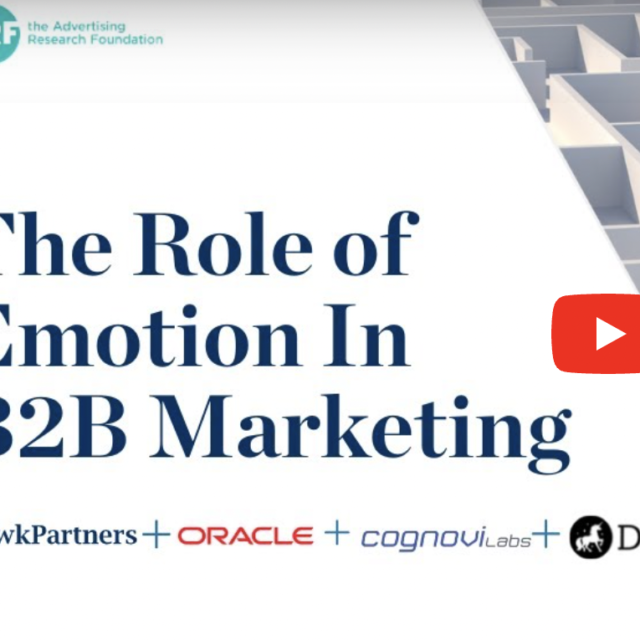Think about your company’s market. Which competitors routinely land the most important accounts? In any given market, the companies that have the most meaningful market share are the ones that put in the work to wrangle complexity, develop excellent products, consistently deliver on promises—the list goes on because this type of market position is a result of doing a lot of things really well. This type of success is not incidental—it is earned over time—which is why market-leading companies are big on long-term planning, not just a series of short-term initiatives.
This requires Marketing leadership to demonstrate a commitment to the long gamewith a marketing strategy built to show performance over time, not just in spurts of demand gen campaigns. To be clear, this framing is not about sacrificing this quarter’s revenue in the interest of next quarter’s revenue. On the contrary, a long-term view pushes us to try harder, to think more critically about the decisions we make today so they hold water tomorrow. Think of it as putting up the bumpers in a bowling lane: this consistent protection gives us the freedom to take on more risks and test new techniques, because no matter what, our ball will not end up in the gutter—we have ensured an acceptable level of performance for the Marketing function.
The safety net and guarantor of future rewards is the Brand
It is incumbent on marketing leaders to seek an appropriate balance between brand and demand and create an ecosystem where these two key imperatives operate together. Yet, many organizations don’t have quantitative methods to tie brand to demand, or they allocate outsized funding to demand to show shareholders the quickest results.
Brand is not just what you see, but what you experience. Marketing leaders need to explain how everything the company does impacts the brand’s health, and why the brand’s health is critical to the business’s future potential. This is the hardest part. In a business environment that incentivizes short-term thinking by setting aggressive quarterly targets, it’s tough to tell the story that we need to invest today to net benefits tomorrow. But someone has to do it—and who ever said Marketing was easy anyway?
Big Pieces of the Big Picture: Three Initiatives That Grow Your Brand Over Time
Below, I recommend three important initiatives every B2B company should be on top of to establish a strong brand presence that endures over time. These initiatives are now ‘table stakes’ for competing in an increasingly crowded marketplace where the buyer has more options than ever before.
1. Formalize Customer Success to Raise Customer Lifetime Value (LTV)
Consistently impress and delight customers, extending the average lifespan of customer relationships and increasing the likelihood of cross-sells, up-sells, and referrals.
- Establish a reliable feedback loop between Sales and Marketing by assigning someone to seek the feedback, document it, and act on it. Customer Success and Customer Marketing teams may have been a ‘nice-to-have’ function, but today they’re competitive differentiators. These people advocate for the ‘voice of the customer across the organization in a way that no other team can, giving the business the information it needs to increase stickiness, reduce attrition, and acquire new customers. To make sure your efforts pay off, index higher towards ensuring customer “success” over customer “retention.” There’s a reason the customer success platform Gainsight has recently been valued at over $1 billion, it helps businesses make more money. In one case study on Gainsight’s website, it documented how Ping Identity was able to increase its renewal risk lead time from less than 60 days to 115 days—what could you do if you had 100% more time to save an account from churning?
- Look at this from an organization-wide perspective, to understand strengths and weaknesses, and work to improve the company’s overall health. Ultimately, we’re raising the value conveyed to the customer and helping them realize it. If your product is weak or customer support is awful, you’re already at a major disadvantage because you won’t be able to deliver long-term value.
2. Craft Context-Aware Communications and Experiences to Become an Approachable Company
Give your audiences the content and experiences they expect and look forward to.
- This requires high awareness around product-market fit and customer challenges. You need a deep understanding of the customer’s pain points, measures of success, and perception of value for your offering. The challenge is more complex with every new vertical or market that is added to the target audience portfolio. Thus, growing firms need to be ready to bring on segment-specific marketing teams and resource them appropriately so market positioning is as relevant as possible to their target decision maker. Amazon Web Services and Splunk are world class examples. Most of their marketing events and website messaging is technical in nature, catering to the technologists that make the buying decision and are ultimately responsible for implementation. Both of these companies take this a step further with solution engineers and sales people dedicated to specific industry verticals.
- Remember, humans are cognitive misers, and we’re always trying to get to the bottom line—if it’s difficult to understand what a company does, skepticism kicks in and introduces friction into a prospect’s decision-making process; conversely, if it’s easy to understand, the prospect just needs to decide whether or not to get in touch: no friction, more clarity, quicker decision.
3. Build Community and Educate the Market
These “surround” initiatives boost brand perception while generating net new demand, growing brand awareness, and accelerating deal velocity.
- Bring people from across industries and markets together, so that vendors, employees, customers, and media can build ideas and relationships, while rallying around a central force, your company’s brand. This develops and increases the bonds of trust and credibility in the marketplace and contributes to more qualified leads that are further down funnel and more likely to buy. Before the pandemic, Salesforce’s annual Dreamforce event would be so heavily attended that San Francisco hotel capacity would max out—this isn’t because people are flying across the nation just to watch product demos, they are there to network with a community of shared interests.
- Nurture a community that educates itself. By default, a company’s education-focused initiatives are self-serving. No one looks forward to sitting through product pitches. So instead of focusing on the product, we need to focus on the customer persona and provide them with value that helps them improve their work performance. This is where community comes in. When it comes to becoming more successful on the job, we benefit more from interactions with peers who deal with similar challenges than information shared by product vendors. This is why winning brands create environments where these connections can take place, keeping the company’s products and services somewhere in the conversation, and ultimately benefiting from the overall success of the people in our community.
<this article was originally published on Little Black Book>











